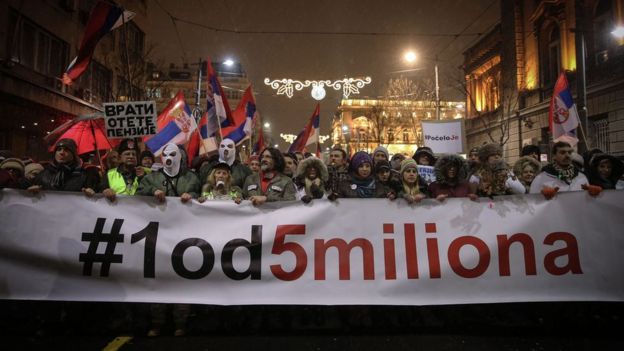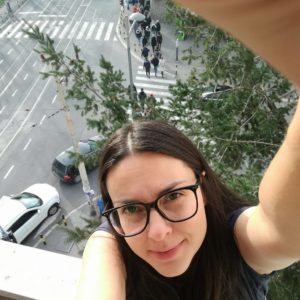
The end of 2018 and the beginning of 2019 was marked by a wave of mass anti-government protests in Belgrade. The direct cause for the first protest held on December 8th was the attack on the leader of the Serbian Left, Borko Stefanović, ahead of a forum of the newly formed coalition of the opposition parties, Alliance for Serbia, in the City of Kruševac. The first protest was organized by the Alliance under the banner “Stop to Bloody Shirts”. After the crowd expressed its dissatisfaction with the proposals to continue protests after the New Year break, the organization of the protest was taken over by an allegedly independent and non-party group of citizens. Since then, the protest has been organized under the name #1outof5million. The name was a reaction to President Vučić’s statement that he would not talk to those who protested even if there were 5 million. Organizers described the protest as a peaceful non-political response of citizens to the rule of Aleksandar Vučić, to daily violence and lies.
The demands of the protest remain unclear. At every subsequent protest, a new request appeared. Initially, the main demand was to discover the initiators of the attack on the leader of the Serbian Left, Borko Stefanović, and the journalist Milan Jovanović, as well as those responsible for the murder of the politician Oliver Ivanović. Subsequently, they grew in number: a fair election process, five minutes on RTS for the reporting of the protests, more media space for the opposition, and the dismissal of the Minister of Police, Nebojša Stefanović.
Vučić’s regime––the main target of the protests—has been gradually built ever since 2012 when the Serbian Progressive Party came to power, following years of rule by so-called democrats who prepared the ground for his rule. His centre-right Serbian Progressive Party has overseen the privatization of public services by its party machinery, the further degradation of the social welfare system, the financing of foreign investors by public money, the degradation of labour rights, the abuse of the judiciary, nationalist manipulation mostly over the status of Kosovo, further stimulation of the debt economy, and neo-colonial dependence on the EU. Party-controlled media machinery, covers the growing unemployment, misery, and the breakdown of public health, with narratives about the upcoming golden age of Serbia.
While it is certain that there are reasons for widespread dissatisfaction and that the protests are an expression of authentic discontent, it is not those indignant at the unbearable situation in Serbia who control the protests. The protests are dominated by mass dissatisfaction but there is also an ubiquitous uneasiness and a disconcerting sense of not belonging. What is rotten in the current Belgrade protests?
They should leave and those should not return
There are reasonable suspicions that the Alliance for Serbia still pulls the strings of the protest even after the official change of the protest organisers. The Alliance for Serbia is a coalition of opposition political parties, amongst others: the Democratic Party, the party responsible for years of devastation of Serbia, the Serbian Left, which has found it difficult to draw a consistent left line, the Movement Dveri, an advocate of ultra-nationalist and xenophobic, patriarchal and homophobic right wing policies, the right-wing Democratic Party of Serbia, and obscure ultra-rightist parties like Healthy Serbia. The informal leader and initiator of the creation of the opposition bloc is Dragan Djilas, the former president of the Democratic Party and former Mayor of Belgrade, known, among other things, for the violent displacement of Roma with bulldozers and the introduction of a new type of social housing based on metal containers.
The demands of the protests can be seen to reflect the 30 points of the Alliance for Serbia program. These points as well as the protest itself reflect the general ideological confusion articulated in the heads of the political elite that have claims to power in the post-Vučić Serbia. On the one hand, the Alliance is demanding “a society measured by the highest European standards”, while on the other, it is denying the recognition of Kosovo’s independence. As a solution to economic misery, the program favours domestic entrepreneurs, as opposed to the hitherto-favoured foreign investors. As a solution to poverty, the program calls for a solidarity approach as opposed to clear social policy. What they proclaim is a national capitalism with social elements that can be no cure for the situation that has arisen after decades of devastating “transition”. The Alliance is playing the card of unity in an attempt to win voters, while it uses the current protests for a media breakthrough.
The unprincipled character of the Alliance has caused many disagreements at the Belgrade protests. The sympathizers and voters of each individual party within the coalition express unease about it, as do those who do not support the coalition in any way. Additional tension is produced by statements from opposition leaders who blackmail Serbian citizens with statements such as: “If you are not with us, then you are for them”.
Stop to the bloody worker suits
In order to preserve the illusion of unity in the protests, the organizers are trying to conceal internal tensions and antagonisms by bringing the dignity of the responsible citizens to the forefront. Instead of politics, appeal is made to the intellect, to the prettier Serbia, to knowledge, to cultured Serbia. Still, growing tensions cannot be covered up with rotten apolitical (petty bourgeois) babbitry with a national prefix that represents the interests of the Belgrade fine middle class.
Divisions in the irreducible crowd that walks the streets of Belgrade have materialized so far like the eczes that manages to break through the membrane of the hypernormalized management of the protest. Already at the first protest, some protesters spat and threw snowballs at the windows of Belgrade Pride shop window and clutched stickers “Against the Abnormal”. On the following protest march the same right-wing homophobe groups continued to intimidate with banners like “Gays and Lesbians sold Kosovo”. At the second gathering, the actress Mirjana Karanović and the coach Duško Vujošević were forbidden from speaking to the crowd. The reason was the disagreement of the nationalist Democratic Party of Serbia, who labelled the potential speakers anti-Serbian elements. The protest organizers did not respond to this incident.
It is also important to bring up the conflict between the protest organizers and the initiative Joint Action Roof Over the Head because it exemplifies which violence is actually considered legitimate on these protests and who is entitled to the position of the victim. Joint Action gathers individuals and organizations in the struggle for the right to housing. The group is known for applying the direct-action method in solidary struggles with all those facing eviction. Thanks to this group, the problem of forced evictions and the ensuing homelessness has become recognized widely in Serbia. The initiative was at first prohibited by the protest organizers from sharing its leaflets. It then responded by appearing at the next protest with slogans “Stop to Bloody Workers’ Suits”. The message referred to two workers employed at the construction site of residential complexes constructed as a part of Belgrade Waterfront megaproject, who lost their lives due to poor working conditions. In order to protect the interests of investors, pro-government media presented the death of workers as their individual responsibility due to suicidal behaviour. The Joint Action pointed out its own demands: the moratorium on forced evictions and the safety of workers in the construction industry. After the protests, the leader of the Serbian Left, Borko Stefanović, wrote on twitter: “You had a brilliant banner “Stop the bloody workers suits”, because of course my broken head is that of a dirty thief and a yellow head [yellow is the political colour of the formerly ruling Democratic Party] and it does not matter.” In this way, the leader of the Left showed that the protest is not a place where justice will be sought by those who suffer most from repression and that the only legitimate violence is the one against political opponents.
The protest organizers displayed not only their disagreement with the ruling regime but also with the expression of Serbian workers’ legitimate anger. This rage is repressed through the gentle civil protest of “a beautiful and normal” Belgrade that traditionally excludes those who suffer most from the consequences of the regime.
Is there anything new on the horizon?
Unfortunately, the protests in Belgrade and Serbia are not a sign of the new politics as announced in Mass protests across Europe show that a new politics is on the horizon. So far as things stand, there is not much hope of bringing an unexpected political novelty or outcome. The protesters managed to upset the authorities, who, in response, employed the media machinery of smoke and mirrors. Ruling elites engaged in counting and speculating about the number of people on the streets to draw attention away from substantive issues. However, the ideological and political confusion, which in this protest reaches a new level of absurdity, is in the interest of the regime. In the “best” case scenario, the outcome of the protest could be Vučić’s dismissal and the enthronement of someone like Djilas, which at least for now is not very likely. Vučić has already announced early elections in order to reaffirm his legitimacy in the impossible electoral conditions.[1]
It is important to emphasise that these protests are not spontaneous, nor are they a sign of Serbian awakening, as some opposition politicians have claimed. In Serbia, for some time, social, economic and political tensions have an expression in self-organized disagreement. Protests have been organised by workers of companies such as Goša, IKL and IMT, the Post Office, and Elektroprivreda Srbije, residents of Bristol Hotel resisting eviction, in Niš against the privatization of the Niš airport, angry mums organised against a new Law Support for Families with Children, there were protests against dictatorship after the April elections etc. These and many other initiatives contribute to building a wider movement through recognizing and highlighting injustice, articulating the demands for social justice, and mobilizing support on the way to gain political influence and build parallel infrastructures in a situation of occupation of public resources. Many of these groups, including other Left leaning initiatives and organisations, take part in the protest in an attempt to intervene in it and politicize it in a different way. Still the last thing such initiatives should do is to renounce their autonomy on behalf of political careerists
[1] To what extent the current government is an undemocratic and dangerous player is shown by the situation with the elections in Lučani. Serbian Progressive Party activists stormed the municipality, pressured citizens to vote for them, and intimidated all those including journalists who were trying to document the process.
 Ana Vilenica is a housing activist and a freelance researcher. She edited the book Becoming a Mother in Neoliberal Capitalism (2013, 2016) and co-edited books On the Ruins of Creative City (2013) and Art and Housing Struggles: Between Art and Political Organising (forthcoming). She is member of the Radical Housing Journal collective. She lives and works in Pancevo and Belgrade.
Ana Vilenica is a housing activist and a freelance researcher. She edited the book Becoming a Mother in Neoliberal Capitalism (2013, 2016) and co-edited books On the Ruins of Creative City (2013) and Art and Housing Struggles: Between Art and Political Organising (forthcoming). She is member of the Radical Housing Journal collective. She lives and works in Pancevo and Belgrade.

